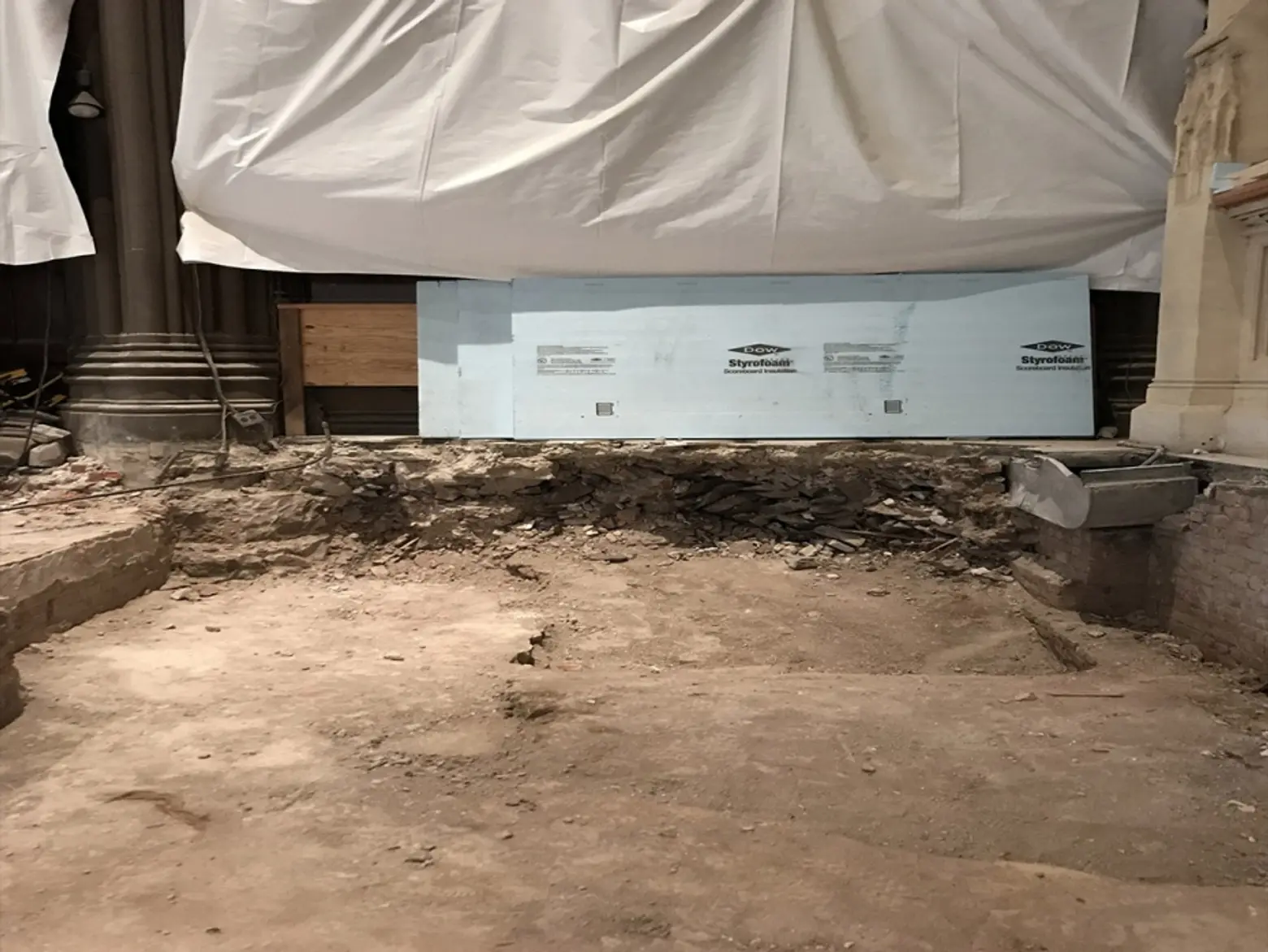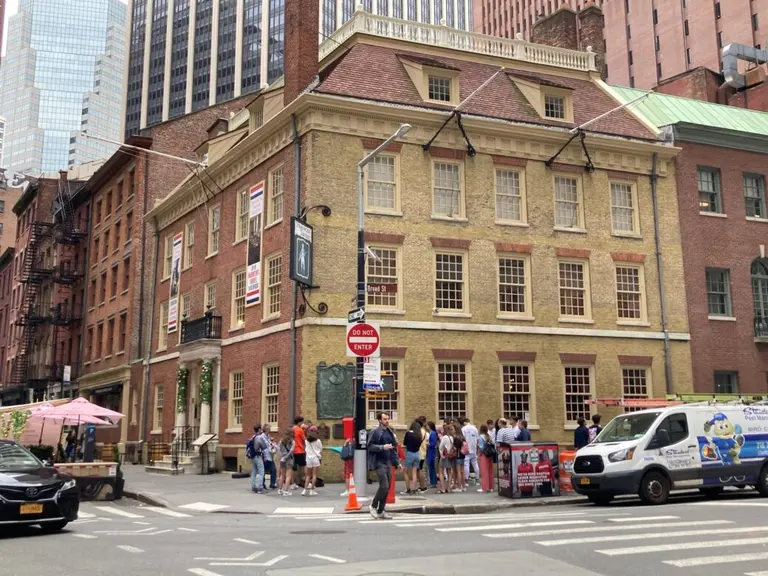Behind the scenes at Trinity Church’s $112M historic restoration

Hardhats aren’t your typical church-going attire, but they were necessary at Trinity Church when Vicar Rev. Philip Jackson led a behind-the-scenes tour of Trinity’s ongoing $112,000,000, two-year restoration. The project, officially known as a “rejuvenation” of the facilities, began on May 7, 2018, and is slated to be finished in the spring of 2020. Now six months underway, the meticulous work, headed by architect Jeff Murphy of Murphy Burnham and Buttrick, will preserve Trinity’s landmarked church building while “enhancing the overall worship experience,” by making the church more accessible and welcoming.
Weaving our way between scaffolding and rubble in one of New York’s most iconic naves, we saw the very foundation of Trinity Church’s past and got a glimpse of its future. From the finer points of organ-voicing to some of the first examples of American stained-glass, check out 10 of the most exciting behind-the-scenes secrets of the Trinity Church Restoration.
 Trinity Church today, courtesy of Trinity Wall Street
Trinity Church today, courtesy of Trinity Wall Street
1. This rubble has been part of the foundations of all three Trinity Church buildings, dating back to 1696
There has been a Trinity Church at Wall Street and Broadway since 1696. The structure that stands today, Richard Upjohn’s 1846 neo-Gothic masterpiece, is Trinity’s third church building. And the Parish’s history rests in the church’s very foundation: The same stones that were used in the foundation of the 1696 and 1790 churches were used again in 1846. They will remain at the foundation of the church as the restoration project continues.

Photo by Lynn Goswick/Trinity Church Wall Street
2. Meanwhile, the nave’s third-story windows date to the 1960s
Not every part of the church is quite as historic as that foundation stone. In fact, the nave’s third- story windows would be more recognizable to John Lindsay than George Washington. They date to the 1960s and won’t survive the restoration. Instead, they’ll be replaced by new windows designed to brighten the space. Pendant lights over the pews will also add to the luminosity.

Photo by Lucie Levine for 6sqft
3. It will take a year to restore the stained glass behind the altar
According to Jeff Murphy, the project’s chief architect, this will be one of the most challenging parts of the restoration. “This is such a historic building,” he said. “Just getting it right will be critical.”
The stained glass window is particularly historically significant because it stands out as a rare example of early American stained-glass. In many of New York’s other houses of worship, including St. Patrick’s Cathedral (which Murphy also restored), the stained glass was created in Europe and imported. But at Trinity Church, the stained glass is American-made. In fact, some of it was made on-site. During the restoration, all of the lead in the stained-glass will be replaced, and the window will be outlined in gold-leaf to make it stand out.

One organ will be installed where the tarp on the right hangs now. Photo by Colin Winterbottom/Trinity Church Wall Street
4. There will be over 7,000 pipes in Trinity’s new organs
As part of the rejuvenation, the church will get three new organs, but installing them is just the beginning. Making them sound just right, a process known as “organ voicing,” can take up to a year. To do it properly, trained musicians with an ear for pitch and tone will actually shave each organ pipe to get the perfect sound.

See the painted plaster to the right of the altarpiece? Photo by Lucie Levine for 6sqft
5. All of the plaster in the nave will be painted to look like stone… and sport painted pink grout
When he designed Trinity Church, Richard Upjohn had the plaster walls of the nave painted to look like stone. Some of that painting survives today, to the right of the altar’s stained-glass window, but most of it was painted over. The Rejuvenation will restore that painting, as Upjohn conceived it, including some quirky coloration: When artisans painted the plaster to look like stone, they added real grout over the painting to make the effect even more convincing. Surprisingly, the grout they used was pink. Now, the entire church will get that treatment

Photo by Colin Winterbottom/Trinity Church Wall Street
6. Another restoration in 1876-1877 turned the church’s entire ceiling bright blue with gold stars!
Pink grout might seem like a bright choice, but when it comes to paint jobs, that’s nothing. Changing tastes during the Victorian Era led to a restoration in the 1870s under the auspices of architect Frederick Clarke Withers. The Withers restoration brought the heavens inside the church, making Trinity’s ceiling resemble a night sky.
The fact that there have been previous major restorations at Trinity makes this one even more intriguing. The vicar explains, “When we talk about restoration, the question is restoration to when?” This rejuvenation project answers that question in a couple of ways, choosing some portions of the church to restore to their 1846 specifications, and others to their 1876 specifications.

Photo by Lucie Levine for 6sqft
7. The Mosaic in the Astor Reredos will be meticulously recreated
For example, the Astor family donated the church’s extraordinarily intricate decorative altarpiece, now known as the Astor Reredos, in 1877 in memory of William Blackhorse Astor. The rejuvenation will restore it to its original glory, working with artisans to recreate the piece’s rich mosaic.

This red line indicates the original 1846 Chancel Line. Photo by Lucie Levine for 6sqft
8. The rejuvenation will restore the original 1846 Chancel Line
At the same time, Trinity’s nave will be restored to the original 1846 Chancel Line. That spatial configuration will allow for much more room in front of the altar. In fact, there will be space for up to 175 more chairs, and the church plans to use the space for expanded programming.

A foundation for a level chancel. Photo via Trinity Church
9. The entire Chancel will be on one level instead of three
The rejuvenation’s most noticeable change may also be its most welcome. To increase accessibility for those with limited mobility, the entire chancel will be reset on one level instead of three. With a level chancel, the Vicar points out, anyone using a wheelchair will be able to celebrate mass from directly behind the altar. Not only that, the church’s entire campus will become more accessible. By the time the rejuvenation is completed, you will be able to navigate the church, its grounds, and its new parish Commons at 76 Trinity Place using a wheelchair.

Rev. Philip Jackson shows off architectural plans for the Rejuvenation, via Trinity Church
10. Vicar’s Vision
A more accessible Trinity is part of the Vicar’s vision for the future of the church. He sees the church and the Parish commons as a community hub for Lower Manhattan. “We’ve been in the neighborhood over 320 years,” he says, “and the neighborhood means a lot to us.”
Since the Vicar himself will be in charge of new programming at the church and commons after the rejuvenation, he plans to open the church’s facilities to the community. For example, he hopes the gymnasium being built in the Parish Commons will be used by school kids in Lower Manhattan. Evoking another New York institution a little way uptown, he says, “This will be like the 92nd Street Y of Lower Manhattan.”
RELATED:
- Ten secrets of the Eldridge Street Synagogue
- Behind the scenes at the Loew’s Jersey City: How a 1929 Wonder Theatre was brought back to life
- St. Patrick’s Cathedral Reveals $177M Restoration, Now What?
 Lucie Levine is the founder of Archive on Parade, a local tour and event company that aims to take New York’s fascinating history out of the archives and into the streets. She’s a Native New Yorker, and licensed New York City tour guide, with a passion for the city’s social, political and cultural history. She has collaborated with local partners including the New York Public Library, The 92nd Street Y, The Brooklyn Brainery, The Society for the Advancement of Social Studies and Nerd Nite to offer exciting tours, lectures and community events all over town. Follow her on Twitter and Instagram.
Lucie Levine is the founder of Archive on Parade, a local tour and event company that aims to take New York’s fascinating history out of the archives and into the streets. She’s a Native New Yorker, and licensed New York City tour guide, with a passion for the city’s social, political and cultural history. She has collaborated with local partners including the New York Public Library, The 92nd Street Y, The Brooklyn Brainery, The Society for the Advancement of Social Studies and Nerd Nite to offer exciting tours, lectures and community events all over town. Follow her on Twitter and Instagram.















































